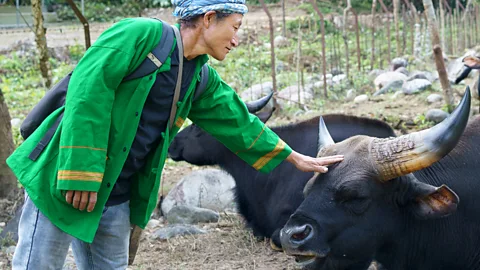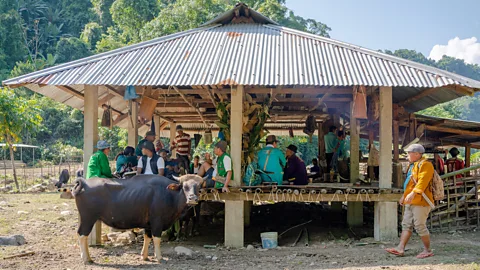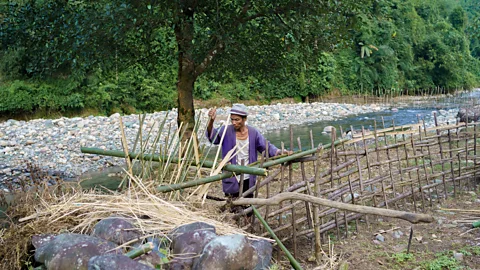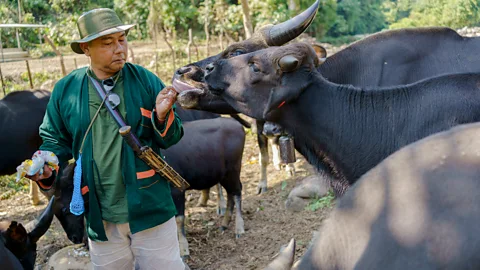The indigenous community protecting Himalayan sacred cattle in India
 Millo Ankha
Millo AnkhaThe mithun, a sacred cattle species in the Himalayas, is threatened by deforestation and climate change. An indigenous community is building "living fences" to protect this endangered species.
In the eastern foothills of India's Himalayas, livestock farmer Yang Ering Moyong slips on a baggy shirt and trousers and heads out in the early morning. As she stomps through the dense shrubbery in the hills surrounding the village of Mirem, she lets out a high-pitched call summoning her mithuns, a semi-wild and endangered cattle species, back from the woods.
The 39-year-old mother of two, who is a member of the indigenous Adi tribe of Arunachal Pradesh, is the only female herder in her village. She started rearing mithuns when her husband died eight years ago. It is a tough business, she says.
"My in-laws owned as many as 50 mithuns in 2013. Almost half of them were eaten by wild dogs. I had to sell a few of them as they entered into other farms and destroyed crops," Moyong tells BBC Future Planet. To cover her family's expenses, the herder also works as a state-appointed educator teaching women in Mirem and other villages entrepreneurial skills.
Climate Guardians
This article in the Climate Guardians series was supported by funding from the European Journalism Centre, through the Solutions Journalism Accelerator. This fund is supported by the Bill & Melinda Gates Foundation.
Managing her herd comes with a hefty financial burden. "In the year 2019, I had to pay a total of Rs 40,000 ($480/£381) for crop damage when my mithuns strayed into other people's homes," she says, adding that she struggles to support her family on her monthly income as an educator of Rs 12,000 ($144/£115) when she has to pay for five to six trespasses each year.
To prevent the mithuns from straying, Moyong and other members of the indigenous Adi community have constructed "living fences" from barbed-wire and stumps of orchid trees along the contour of the Himalayan foothills. The Adi community view the mithuns as sacred and believe that the existence of everything on Earth is tied to the birth of the semi-wild bovine species, says Abhishruti Sarma, a researcher at Ashoka University in India and author of the book Changing Affinities, which explores indigenous communities' relationship with the mithuns.
"For the indigenous Adi community of Arunachal Pradesh, the existence of everything on the planet is tied to the birth of the mithun. When the mithun was born Dadi Bote, the god of animals became its custodian," says Barun Taki, one of the mithun herders and the former president of the Mirem mithun farmers' collective.
"Dadi Bote brought mithuns to the world for us. It is our duty to rear and look after them," says Taki. During the Solung festival, which is held every September in the state Arunachal Pradesh, the community prays to Dadi Bote to increase the number of mithuns, protect them from falling off the cliff edges and from diseases such as the foot-and-mouth disease, he says.
 Millo Ankha
Millo AnkhaMithuns, which have been classed as "vulnerable" by the International Union For Conservation of Nature (IUCN), reside in forests and hilly terrains crisscrossed with streams, ponds, and lakes, below an altitude of 6,000m (19,685ft) with temperatures ranging between 20C and 30C (68F and 86F).
Moyong and other indigenous herders in north-east India rear mithuns in a free range ecosystem, allowing the cattle to roam free in the wild, without any supplementary feed except salt.
Rising temperatures and human activities, such as forest logging and deforestation, have started threatening the mithuns' habitat in recent years.
According to a 2011 study, temperatures are expected to rise by at least 1.9C (3.4F) between 2021-2050 in parts of Nagaland. In India's north-east region the number of yearly extreme rainfall events is projected to increase by 26% by 2050, according to the study.
These climate impacts are expected to lead to a fall in mithun numbers due to a lack of available food and a rise in foot-and-mouth diseases, says Sarma.
Rising temperatures and erratic rainfall impacts the mithun habitat by altering the distribution and composition of vegetation, says Girish Patil, director at the Indian Council of Agricultural Research National Research Center on mithun (ICAR-NRC) in Nagaland, India. "Extreme weather events, such as droughts and floods, can further exacerbate habitat degradation and fragmentation, placing additional stress on mithun populations," he says.
Deforestation is also reducing the availability of suitable grazing areas for mithuns, says Patil. While there haven't been any studies analysing the increase in human-mithun conflict, decreasing forest cover "enhances the chances of mithuns venturing into agricultural field, leading to conflicts", he says.
According to analysis by Global Forest Watch, India lost 23,300 sq km (8,996 sq miles) of tree cover in 2001-2023. Nagaland lost 259 sq km (100 sq miles) and Arunachal lost 262 sq km (101 sq miles) of forest during this period, according to Global Forest Watch.
"If this continues for the next 40-50 years, there will be no forest. When there is no forest, there cannot be any mithun," says Kobe Khate, senior technical officer at ICAR-NRC.
 Millo Ankha
Millo AnkhaTo protect the mithun habitat and the species, scientists at the ICAR-NRC worked with the Adi community to build durable "living fences" in 2022. Running between the eastern foothills of the Himalayas and across the Remi river, the "living fences" are constructed from barbed-wire and stumps of orchid trees, which the mithuns graze on.
ICAR-NRC also helped the farmers build a night shelter from bamboo sheets for their mithuns and calves. The mithuns are only allowed to forage in the fenced grazing area during the day and brought back to the shelter in the evening. The cattle previously roamed freely in the forest, returning of their own accord, which sometimes took years.
Moyong lets her mithuns out to graze early in the morning and locks them in the shelter at night. "After the installation of the fences, I don't have to worry about my mithuns straying off into other fields in the winter," she says. In 2022, she had to pay Rs 7,000 ($144, £115) for one straying incident.
"Planting trees in between reinforces the fences against weather and intruders," says Taki. Every six months, the farmers tend to the fences, clearing out weeds, and checking them for damage.
Taki says heavy rainfall has previously led to dangerous currents in the Remi river submerging the fences. "The fences cannot stand the fury of the river during rainy season. This is rare but happens," he says.
Mithuns act as important ecosystem engineers in north-east India. "They are essential for ecosystem health as their foraging activities aid in the dispersal of seeds of various plants and trees. They are efficient recyclers of nutrients as they consume vegetation and subsequently deposit nutrient-rich manure, enriching the soil for plant growth," says ICAR-NRC's Patil.
A 2010-11 study by ICAR, which interviewed 200 farmers in Nagaland, found that fencing off the mithun-rearing area had helped other livestock thrive and that the mithun's dispersal of seeds and spreading of manure had boosted plant growth as well as grassland and fodder production.
The practice of grazing livestock in naturally forested areas and interlacing trees and shrubs with pasture, known as silvopasture, also helps sequester carbon dioxide (CO2). A 2023 study concluded that expanding silvopasture across up to 250,905 sq km (96,875 sq miles) in the eastern US could capture between 4.9 million and 25.6 million metric tonnes of CO2 emissions per year.
"Similar to other livestock, mithun-influenced ecosystems with their dense vegetation and nutrient-rich soils contribute to carbon storage and cycling, mitigating greenhouse gas emissions," says Patil.
"The mithun moves freely in the wild. It feeds on relatively smaller plants as it cannot reach high. After eating, it poops out the seeds as it moves, regenerating forests," says Kewiribam Zeliang, a 47-year-old mithun farmer in Nagaland.
The fences are also helping tackle deforestation, says Zeliang. "No one is allowed to cut trees after the fences have been put up. If anyone cuts a tree inside the community forest, he has to pay a fine of Rs 500 (£4.6, $6) or else he loses welfare facilities that the village council oversees," he says.
 Millo Ankha
Millo AnkhaOver 400km (249 miles) away from Mirem, in Tening village in Nagaland, the indigenous Zeliang tribes rear their mithun herds. The steep forested Naga hills, not far from the India-Myanmar border, provide the perfect climate for mithun rearing, with high elevation (800-1,500m/2,600-4,900ft) and cool temperatures.
Twenty years ago, there were about 300 mithuns reared by 30-40 herders. But in 2016, there were just 50 mithuns with eight owners, as the rest were shot by farmers when they snuck onto their farms or were killed by wild dogs, farmers in Nagaland tell BBC Future Planet. As a result, many stopped rearing mithun, and migrated to other towns for work.
In 2013, Zeliang's family owned 16 mithuns. After seeing them fall prey to attacks by farmers and wild dogs, he stopped rearing them. "Most of the mithun were shot at by farmers when they strayed into their agricultural land and destroyed their crops. The rest of them were wiped out by foot-and-mouth disease outbreaks and wild predators," he says.
The "living fences" have replaced old tree stumps which used to surround the mithun grazing area. "Mithuns were let loose in the community forest before, and they would easily cross beneath fences made of the large stumps of the wild black cherry tree. These fences would dry up and collapse," says Zeliang.
Facing deep losses, he became an English primary school teacher for six years. Then in 2019 he went back to mithun rearing after the ICAR-NRC introduced 20km (12.4 miles) of barbed wire bio-fences along the crest of the hills surrounding the village.
"This reduced the backbreaking labour of dragging logs of wood higher up in the hills and repairing the worn-out fences more than twice in a year. Barbed wire fences are easier to maintain, as they can last for two to 10 years if maintained well," says Zeliang. Mithuns are unable to jump over these fences, he adds.
He says mithun rearing has enabled him to earn enough income to send his children to school, and possibly even university.
 Millo Ankha
Millo AnkhaSince these "living fences" were introduced, the mithun population has increased from 50 in 2016 to 70 in 2020, according to a report monitoring this intervention by Khate and other scientists at ICAR-NRC. The farmers made a total profit of Rs 9,75,000 ($11,690/£9,321) during this period.
Scientists believe the new fences and grazing system have helped reduce the mithuns' overall mortality rate. "One of the notable achievements from the fences has been the increase in the mithun population," says Patil.
As of 2019, the total mithun population in India was 390,000, as per the 20th livestock census. "The population has shown an unprecedented growth rate of 30%, surpassing that of other livestock," says Patil. "Semi-intensive units with proper fencing keeps mithuns away from cropped areas, reducing conflict with farmers and their eventual death."
Carbon Count
The emissions from travel it took to report this story were 90kg CO2. The digital emissions from this story are an estimated 1.2g to 3.6g CO2 per page view. Find out more about how we calculated this figure here.
Forty-year-old Kiphutlak Newmai previously owned two mithuns but was forced to sell one to pay for her children's education. "And the other one was either killed in agricultural conflict or got lost in the wild," she says.
But after realising the economic benefits of rearing these semi-wild cows, she purchased a mithun in 2023.
In Nagaland, male caretakers rear the mithuns. In exchange, the women provide the male herders with food.
In Mirem, Moyong has hired a caretaker for the price of one mithun to rear her six female cows on a contract of five years. "I find it difficult to actively participate in mithun rearing as my society doesn't consider me as an equal for that role," she says.
Sarma says that unmarried or widowed women often pay a male caretaker as it is unsafe for them to venture deep into the forest in search of their mithuns.
Despite these barriers, women are already benefitting financially from rearing mithuns, says Sarma.
Newmai agrees: "Owning mithuns is a step to financial freedom. When the need arises, I hope some farmer will pay a strong price for my mithuns."
 Millo Ankha
Millo AnkhaThe new fences have also presented challenges. Establishing these protected units outside the states of Nagaland and Arunachal Pradesh can cost farmers up to Rs 50,000 ($600/£478) and more funding is required from the government, according to the scientists at ICAR-NRC. Scaling up to other parts of India depends on factors such as availability of grazing land and resources.
"Mithun is primarily a meat animal which needs to be reared for three to four years before [slaughter]. Grazing land is a must for rearing mithuns and compared to the free-ranging system, rearing mithuns may not be viable economically for farmers," says Patil. "Tribal farmers generally do not have the budget for establishing such units."
In Mirem, the villagers admit that fences have succeeded in reducing human-mithun conflicts, but have not prevented attacks from other predators, in particular Asiatic wild dogs, which are classed as endangered on the IUCN Red list.
"The number of mithuns have [remained] constant in the village as the calves are killed by the wild dogs," says 52-year-old Oyem Ering, Moyong's cousin.
As the fences are situated close to the forest, mithuns remain exposed to attacks by packs of wild dogs. The scientists at ICAR-NRC are working on a solution, according to Patil. The plan is to keep mithun calves in separate enclosures with milk alternatives until they are six months and are free to roam in the wild.
The scientists are holding discussions with the forest department about the attacks. Losses of around 5% of the mithun population to wild dogs is considered unavoidable in a free-grazing system in forests, says Patil.
Mithun rearing is also less methane-intensive than cattle farming, research shows. Agriculture is the largest human source of methane emissions, accounting for almost 40%, according to the International Energy Agency. (Read more about why agricultural methane is a climate action blindspot).Methane breaks down in the atmosphere in just 12 years, which is much faster than the centuries taken by carbon dioxide (CO2) – but the greenhouse gas is also about 80 times more powerful than CO2 over a 20-year time span.
An unpublished study by scientists at ICAR-NRC suggests the rumen of the mithun may produce relatively low levels of methane.
Moyong says the living fences have eased the financial burden she previously faced. "Since the fences have been set up, I don't see mithun trespasses in my village," she says. "It was such a financial drain on my income. The fenced-in forests are strictly off-limits to outsiders cutting down trees. The forest is a free pass for wild animals only."
--
For essential climate news and hopeful developments to your inbox, sign up to the Future Earth newsletter, while The Essential List delivers a handpicked selection of features and insights twice a week.
